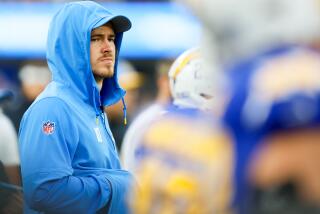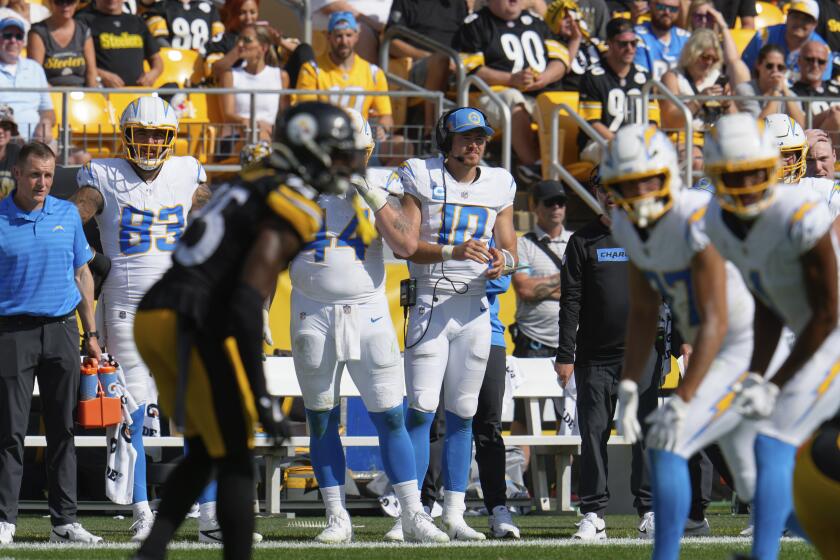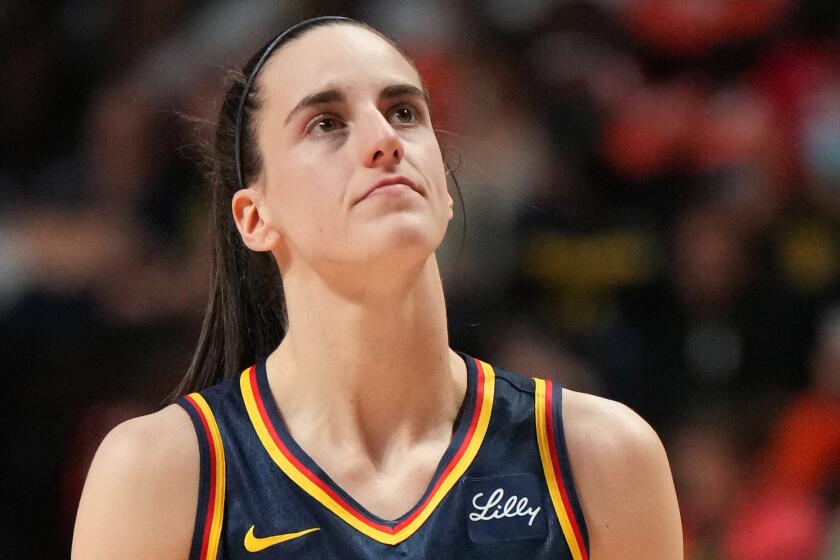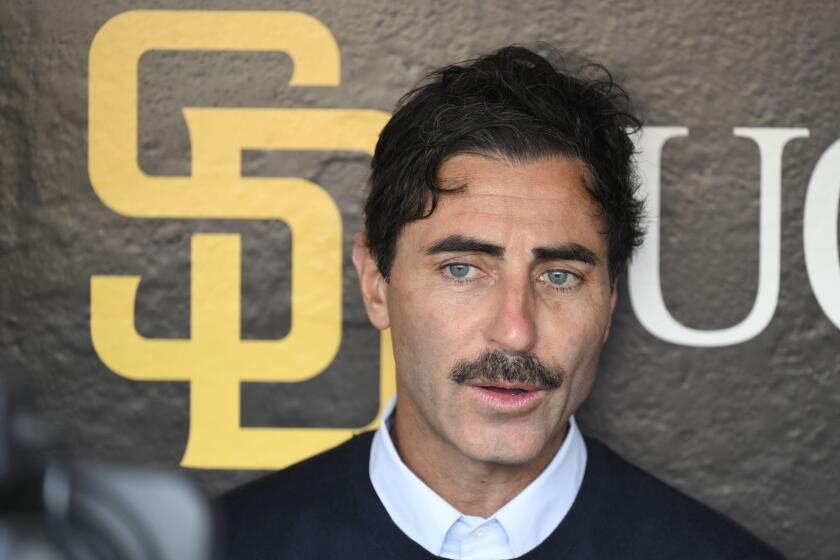As career winds down, Peyton Manning takes it in and makes adjustments

Denver Broncos quarterback Peyton Manning enters the field from the tunnel before a preseason game against the Seattle Seahawks on Aug. 14.
As he gears up for his 18th NFL season, the quarterback who wears No. 18 for the Denver Broncos can see his illustrious career unfold in a collection of mental snapshots.
“There’s a certain age that you hit when you start doing that,” said Peyton Manning, 39, standing in a quiet hallway at team headquarters. “I really enjoy interacting with the fans. My kids have been out to practice a bunch this year. The rookie skits. Things you know will never happen again.”
Manning, the NFL’s only five-time most valuable player, isn’t putting a stop date on his career, nor is he looking at this season as some type of rocking-chair tour. It’s just that, since joining the Broncos from Indianapolis in 2012, after sitting out a season because of a neck injury, he has learned to appreciate the small moments. In that sense, he has savored football through a slow-motion lens.
But in another sense, the Broncos plan to step on the gas this season, putting Manning under center, as opposed to back in shotgun, and simplifying the system under new Coach Gary Kubiak. A big reason for that is the team has so many young players, and a less complex scheme will allow them less thinking, and more doing.
“I’ve always believed in coaching speed on offense and coaching fast,” Kubiak said. “Speed plays through bad situations, in my opinion. So would we like to be in the perfect play? Do we have the guy that can get us there a majority of the time? Yes, we do. But I don’t want us to ever lose our tempo or our speed.”
The Broncos have some inexperienced players at some pivotal spots. Manning’s starting offensive line features rookies at left tackle and guard, and a second-year center who was on the practice squad last season. In other words, three players, zero NFL snaps.
“I’m learning just like they are,” Manning said. “Certain situations obviously call for different things, but as much as we can, if we can get up there and play fast, have these guys coming out and playing aggressive and hitting somebody, that gives them the best chance to succeed.”
Last fall was a tale of two seasons for Manning. He began it at an MVP pace, with 22 touchdowns and just three interceptions through the first seven games. In Week 6 against San Francisco, he eclipsed Brett Favre to claim the all-time record for career passing touchdowns. In the ensuing celebration, Manning’s teammates teasingly kept the historic ball out of his hands.
A few weeks later, it was Manning’s coach, John Fox, who played keep-away by completely changing the offense. Seemingly overnight, after a 22-7 loss at home to St. Louis in Week 10, the Broncos went from a passing to running team. Denver averaged 24.3 carries in the first 10 games, and 33.3 in the final six. Manning never got into a groove — a quadriceps injury late in the season didn’t help — and the Broncos were one and done in the playoffs, losing to the Colts in the divisional round. Later that week, the club showed Fox the door.
“The pendulum swung so far so that instead of getting balance, we kind of swung it too far back to the running game,” said John Elway, the Broncos’ top football executive, while surveying training camp this week from his office balcony. “It was a hard adjustment for Peyton, hard for him to be able to stay loose. When you go from throwing it so much in a game to all of a sudden you’re not throwing it until third down, it was a bit of an adjustment.”
Now comes another adjustment, as Elway hired Kubiak, his old backup quarterback during their playing days in Denver. It wasn’t an obvious choice, because Kubiak showed when he was Houston’s coach that he favors a run-based offense, and prefers his quarterbacks under center and not making a lot of adjustments at the line of scrimmage. Manning has been almost exclusively a shotgun quarterback, particularly in recent years, and constantly directs traffic before the snap.
“It won’t be easy for Peyton,” said his friend, Hall of Fame coach John Madden, who calls Manning among the smartest players in NFL history. “Because he’s always been, ‘What’s the defense doing? What’s the disguise?’ … That was his game. No one figures out stuff better than Peyton Manning. [Opponents] don’t show him the same defenses they show other people. They don’t show him the same defenses they showed him the last time they played. They don’t even show him the same defense in the second half that they played in the first half.”
So if Manning is playing faster, with younger players around him, and not making all his typical tweaks and adjustments at the line of scrimmage, he could be limited in how much he uses his best weapon — his brain. Madden, for one, thinks Manning will adapt.
“If you had a place where you grade for ‘figuring out,’ he’d get an A-plus in figuring out,” Madden said.
Elway scored similarly high marks near the end of his hall-of-fame career. Like Manning, he went from a passing offense to a more balanced scheme at the end of his career, one that showcased Denver running back Terrell Davis, and Elway closed out his era with back-to-back Super Bowl rings.
“The older you get, instead of being the machine, you’ve got to become a cog in the machine,” Elway said. “Even though your mind tells you that you’re still getting better. So there’s an adjustment to that.”
So far, Manning is adjusting just fine. He’s leaner than he’s been in years, and his passes in practice have had an extra zip to them.
“His arm is as good this year as it’s been since he’s been here,” Elway said. “You can just tell by the way the ball comes off his hand. A lot of times, the arm’s moving faster than the ball. But his ball is popping off. He threw a ball the other day farther than he’s thrown it since he’s been here. He’s usually 45, 46 yards. He threw one 50.”
Manning is 6 feet 5 inches, and backup Brock Osweiler is 6-8. That kind of height is a big advantage for a quarterback taking a snap under center because he can see over the towering offensive linemen whose helmets are just a few feet from his face.
And although some quarterbacks who spend the majority of their time in shotgun allow their footwork to get sloppy, that won’t be a problem for the meticulous Manning.
“At our football camp in Louisiana, I think we’re the only camp in the country that still teaches under center, the three-step and five-step drop,” Manning said. “Most everybody is teaching shotgun… I never did shotgun in high school. I was under center quite a bit during my time in Indianapolis.”
Manning likes that when he’s under center, he doesn’t have to take his eyes off the defense, even for a split second.
“You can be looking out at the left cornerback during the snap to make sure whether he’s pressing or bailing,” he said. “Whereas in the shotgun, you’re looking at the ball for that little bit of time.”
Likewise, that’s just the way he approaches these final years of his career. He doesn’t want to blink.
Follow Sam Farmer on Twitter @LATimesFarmer
More to Read
Go beyond the scoreboard
Get the latest on L.A.'s teams in the daily Sports Report newsletter.
You may occasionally receive promotional content from the Los Angeles Times.











